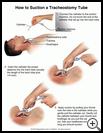
Tracheostomy Care: Warning Signs
What are the warning signs of a blocked tracheostomy?
When a child with a tracheostomy is having serious trouble breathing, they may:
- Be unusually anxious and have a frightened look.
- Be restless.
- Have trouble eating.
- Breathe rapidly.
- Make a wheezing sound.
- Have pale bluish or dusky mouth, lips, or fingernails.
- Show other signs of trouble breathing: The hollow in their neck, the skin between the ribs, and the skin under the breastbone may pull inwards with each breath. Their nostrils may flair with each breath.
If you see any of these signs, immediately suction the trach tube. If the signs continue, change the trach tube and suction again. If your child is still having trouble breathing after the tube is changed, call 911 right away.
What are the warning signs of infection?
Look carefully at secretions in the catheter for signs of infection. Call the specialist in trach care if:
- The secretions are yellow or green, or they have an unusual or bad smell. (During the first 1 or 2 hours in the morning, the secretions may be yellowish, but they should soon become clear or a white color.)
- You see bright red blood in the secretions. (A few streaks of blood or a faint pinkish tinge in the catheter may be normal after a trach tube change.)
- Your child has a fever or is vomiting.
What are the warning signs of dehydration?
Make sure your child has enough to drink each day so that secretions stay thin and don’t block the trach tube. Your child will need to drink extra fluids when sick.
Signs that your child may not be getting enough fluids may include:
- Your child has stopped wetting his diapers or is wetting a lot less.
- Your child goes to the bathroom fewer than 3 times a day.
- You notice a change in the color and smell of the urine. A darker color and strong ammonia smell are signs of dehydration.
Written by Monte Leidholm, RRT, The Children's Hospital of Denver.
Pediatric Advisor 2012.2 published by RelayHealth.
Last modified: 2012-01-27
Last reviewed: 2011-12-13
Last modified: 2012-01-27
Last reviewed: 2011-12-13
This content is reviewed periodically and is subject to change as new health information becomes available. The information is intended to inform and educate and is not a replacement for medical evaluation, advice, diagnosis or treatment by a healthcare professional.
© 2012 RelayHealth and/or its affiliates. All rights reserved.

